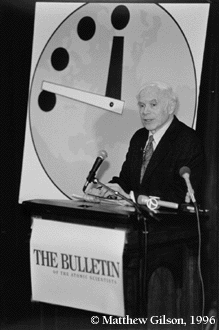 The University of Chicago Magazine February 1996
The University of Chicago Magazine February 1996
Photographs from campus:
Plus items For the Record.

Bruce Cumings, a Northwestern political scientist, summed up the change. "If in 1985 we were to have woken up one morning and learned that missiles were arcing over the horizon," he told his audience, "our last thought would have been, 'It finally happened.' In 1996 we would think, 'How the hell did that happen?'"
An all-out nuclear war is unlikely, agreed the scientists, policymakers, and arms experts assembled in Max Palevsky Cinema-and it has been since communism fell in Eastern Europe. Yet nuclear weapons live on. This past February, the task before the assembled group was to look beyond the good news of an improbable first strike: Have the nuclear risks, from proliferation to terrorism, really subsided since the cold war ended, or are they possibly even growing?
Literally at the center of this gathering was a well-known icon of the nuclear threat: the "Doomsday Clock," which appears on the cover of the Bulletin of the Atomic Scientists, founded at Chicago in 1945 by some of those who built the bomb. Seated before an oversized replica of the clock, Bulletin editors and board members hosted the all-day event to mark the magazine's 50th anniversary and to determine, after hearing from 12 invited witnesses, just how close the world now stands to the midnight of nuclear disaster-to gauge, as the conference title suggested, "What Time Is It?"
Since the Doomsday Clock's 1947 debut, the Bulletin has shifted its minute hand to reflect changes in world security 14 times, charting danger levels as high as "2 minutes to midnight," after the first hydrogen-bomb tests in 1963, and as low as "17 minutes to midnight" in 1991, the last time that the hand was moved.
February's first-ever public setting of the clock reassessed the high hopes of '91. That year, noted the Bulletin's board chairman, Leonard Rieser, SB'43-a former president of the American Association for the Advancement of Science-saw the U.S. and Soviet Union sign the Strategic Arms Reduction Treaty (START); "a new and democratic Russia" emerge from a failed coup; and a post-cold war U.N. finally able to focus on making peace. Many, Rieser said, predicted a safer future: a reduction in weaponry and an end to proliferation, the ratification of START II, tighter control of nuclear material, and a comprehensive test-ban treaty.
As the day of testimony spelled out, many were wrong. Positive signs exist, such as the ongoing removal of nuclear weapons from some former Soviet republics. But witnesses like Igor Khripunov, a former Soviet arms negotiator, pointed out potential threats to peace in Russia, such as its military's nationalist leanings and its financial inability to implement arms-reduction treaties.
And some seeming good news, like 1996's renewal of the Nuclear Nonproliferation Treaty, is in fact mixed. The treaty's extension, argued Mexican diplomat Miguel Marin-Bosch, has eased pressure on its participating nuclear powers to eliminate their weapons. Those nations, said Marin-Bosch, are mired in "the inertia of old habits…[and] the fear of losing their status."
In the world of the 1990s, some witnesses contended, a single Doomsday Clock may be obsolete. Better, they said, to use two timepieces: one to mirror the risk of global nuclear war-set at least as early as 11:30 p.m.-and another for nuclear terrorism or regional conflict. U of C political scientist John Mearsheimer saw the greatest current danger in a nuclear power attacking a non-nuclear neighbor, such as an assault by China on the Republic of Taiwan. Former weapons designer Theodore Taylor, now a disarmament activist, advised setting a "terrorism clock" at just 2 minutes to midnight.
Members of the Bulletin's board of directors listened, weighed the evidence, and announced their decision at a press conference the next day. "To say there is a return to the cold war is too extreme," said board member and U of C political scientist Stephen Walt. "But the trend is in the wrong direction." Besides chilly U.S.-
Russian relations and deteriorating nuclear controls, he said, the board considered aggravating global circumstances like ethnic warring and weak support for U.N. peacekeeping. Despite some progress in world security, added John Pike of the Federation of American Scientists, "governments and people are complacent about the fact that much of our doomsday machinery is still in place."
Leonard Rieser delivered the verdict: "In the past four years, it has become clear that opportunities have been missed, open doors closed." The U.S. and Russia still possess over 35,000 nuclear weapons, he noted, and "the world remains an exceptionally brutish place." With a call for "increased vigilance," Rieser turned to the clock behind him and moved its hands to 14 minutes to midnight, 3 minutes closer to the hour of doom. -A.C.